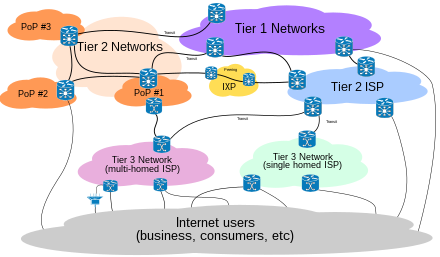An Internet service provider (ISP) is an organization that provides services accessing and using theInternet. Internet service providers may be organized in various forms, such as commercial, community-owned, non-profit, or otherwise privately owned.
Internet services typically provided by ISPs include Internet access, Internet transit, domain nameregistration, web hosting, Usenet service and colocation.
Contents
[hide]History[edit]
The Internet was developed as a network between government research laboratories and participating departments of universities. By the late 1980s, a process was set in place towards public, commercial use of the Internet. The remaining restrictions were removed by 1995, 4 years after the introduction of the World Wide Web.[1]
In 1989, the first ISPs were established in Australia[2] and the United States. In Brookline, Massachusetts, The World became the first commercial ISP in the US. Its first customer was served in November 1989.[3]
On 23 April 2014, the U.S. Federal Communications Commission (FCC) was reported to be considering a new rule that will permit ISPs to offer content providers a faster track to send content, thus reversing their earlier net neutrality position.[4][5][6] A possible solution to net neutrality concerns may be municipal broadband, according to Professor Susan Crawford, a legal and technology expert at Harvard Law School.[7] On 15 May 2014, the FCC decided to consider two options regarding Internet services: first, permit fast and slow broadband lanes, thereby compromising net neutrality; and second, reclassify broadband as a telecommunication service, thereby preserving net neutrality.[8][9] On 10 November 2014, President Barack Obama recommended that the FCC reclassify broadband Internet service as a telecommunications service in order to preserve net neutrality.[10][11][12] On 16 January 2015, Republicans presented legislation, in the form of a U.S. Congress H.R. discussion draft bill, that makes concessions to net neutrality but prohibits the FCC from accomplishing the goal or enacting any further regulation affecting Internet service providers.[13][14] On 31 January 2015, AP News reported that the FCC will present the notion of applying ("with some caveats") Title II (common carrier) of the Communications Act of 1934 to the internet in a vote expected on 26 February 2015.[15][16][17][18][19] Adoption of this notion would reclassify internet service from one of information to one of the telecommunications[20] and, according to Tom Wheeler, chairman of the FCC, ensure net neutrality.[21][22] The FCC is expected to enforce net neutrality in its vote, according to the New York Times.[23][24]
On 26 February 2015, the FCC ruled in favor of net neutrality by adopting Title II (common carrier) of the Communications Act of 1934 and Section 706 in the Telecommunications Act of 1996 to the Internet.[25][26][27] The FCC Chairman, Tom Wheeler, commented, "This is no more a plan to regulate the Internet than the First Amendment is a plan to regulate free speech. They both stand for the same concept."[28]
On 12 March 2015, the FCC released the specific details of the net neutrality rules.[29][30][31] On 13 April 2015, the FCC published the final rule on its new "Net Neutrality" regulations.[32][33]
Classifications[edit]
Access providers ISP[edit]
ISPs provide Internet access, employing a range of technologies to connect users to their network.[34] Available technologies have ranged from computer modems with acoustic couplers to telephone lines, to television cable (CATV), wireless Ethernet (wi-fi), and fiber optics.
For users and small businesses, traditional options include copper wires to provide dial-up, DSL, typically asymmetric digital subscriber line (ADSL), cable modem or Integrated Services Digital Network (ISDN) (typically basic rate interface). Using fiber-optics to end users is called Fiber To The Home or similar names.[35]
For customers with more demanding requirements (such as medium-to-large businesses, or other ISPs) can use higher-speed DSL (such as single-pair high-speed digital subscriber line), Ethernet, metropolitan Ethernet, gigabit Ethernet, Frame Relay, ISDN Primary Rate Interface, ATM (Asynchronous Transfer Mode) and synchronous optical networking (SONET).[36]
Mailbox providers[edit]
A mailbox provider is an organization that provides services for hosting electronic mail domains with access to storage for mail boxes. It provides email servers to send, receive, accept, and store email for end users or other organizations.
Many mailbox providers are also access providers,[37] while others are not (e.g., Yahoo! Mail, Outlook.com, Gmail, AOL Mail, Po box). The definition given in RFC 6650 coversemail hosting services, as well as the relevant department of companies, universities, organizations, groups, and individuals that manage their mail servers themselves. The task is typically accomplished by implementing Simple Mail Transfer Protocol (SMTP) and possibly providing access to messages through Internet Message Access Protocol (IMAP), thePost Office Protocol, Webmail, or a proprietary protocol.[38]
Hosting ISPs[edit]
Internet hosting services provide email, web-hosting, or online storage services. Other services include virtual server, cloud services, or physical server operation.
Transit ISPs[edit]
Just as their customers pay them for Internet access, ISPs themselves pay upstream ISPs for Internet access. An upstream ISP usually has a larger network than the contracting ISP or is able to provide the contracting ISP with access to parts of the Internet the contracting ISP by itself has no access to.[39]
In the simplest case, a single connection is established to an upstream ISP and is used to transmit data to or from areas of the Internet beyond the home network; this mode of interconnection is often cascaded multiple times until reaching a tier 1 carrier. In reality, the situation is often more complex. ISPs with more than one point of presence (PoP) may have separate connections to an upstream ISP at multiple PoPs, or they may be customers of multiple upstream ISPs and may have connections to each one of them at one or more point of presence.[40] Transit ISPs provide large amounts of bandwidth for connecting hosting ISPs and access ISPs.[41]
Virtual ISPs[edit]
A virtual ISP (VISP) is an operation that purchases services from another ISP, sometimes called awholesale ISP in this context,[42] which allow the VISP's customers to access the Internet using services


Tidak ada komentar:
Posting Komentar